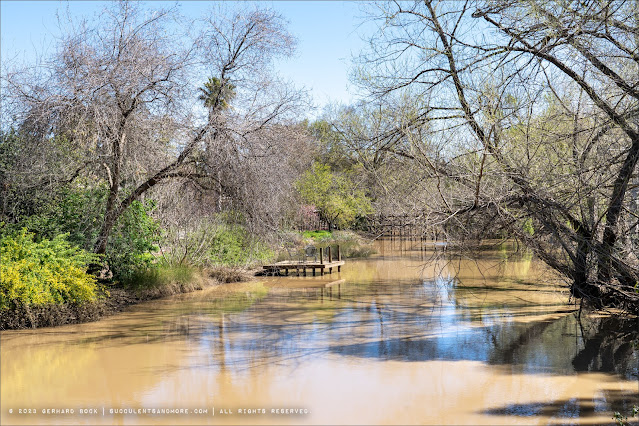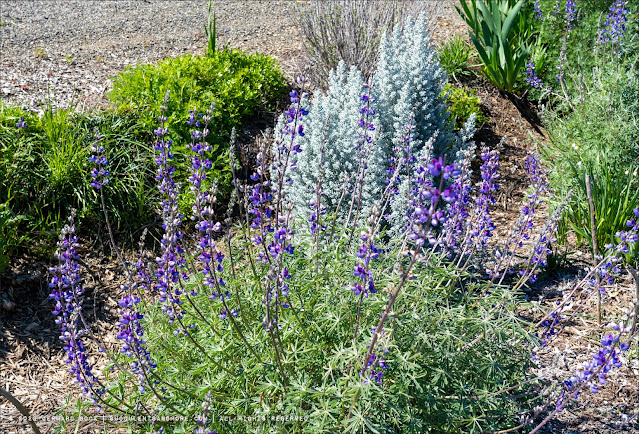Patricia Carpenter is one of the busiest and most dedicated gardeners I know. In addition to sharing her knowledge with the local community as a docent at the UC Davis Arboretum, Patricia used to be a UC Master Gardener, volunteered as a coordinator for school gardens, worked as a garden coach, and led countless workshops. She has written about the native plant gardens under her stewardship in a 5-part series for Pacific Horticulture. I first featured her garden on the outskirts of Davis in this October 2022 post,
Patricia is also a Garden Ambassador with the California Native Plant Society (CNPS) and opens her garden to CNPS members and the public five times a year: in winter, early spring, late spring, summer, and fall. These “seasonal rambles,” as Patricia calls them, are a great opportunity to see the changes happening both in the California native garden Patricia takes care of and in her own garden, which features plants from around the world.
This year’s early spring ramble was last Sunday. It was a picture-perfect day, quite a contrast to the many gray and rainy days we’ve had in recent months. For the first time this year, I truly felt like spring to me.
Patricia’s rambles are informal events: Visitors are free to explore the gardens on their own or join her for a brief orientation. Patricia clearly has a loyal following, with people returning season after season. Last Sunday, Patricia told me, “We had locals and also people from the Bay area, Chico, and the eastern Sierra Foothills. At least 200 people. Humbling!”
 |
| Lemon tree still heavy with fruit and Chasmanthe in full flower |
Below is a map of Patricia’s 1-acre non-native garden. As you can see, it’s divided into multiple areas, each featuring different plants or serving a different purpose. Patricia and her husband have lived here for 40+ years, so the garden is fully mature. For me, as somebody whose garden in a perpetual state of flux, it was wonderfully relaxing to see something so established.
Having such a large canvas to work with, I assumed that Patricia has all the space she needs, but when I asked her, she said that even she is running out room. “Yes, my garden is mature, but constantly in flux as well. Sometimes due to nature—plants dying and spreading seed, and plants or bulbs growing out of their allotted space—and sometimes me editing and planting, i.e. stuffing more in.”
This post doesn’t cover Patricia’s garden in any kind of systematic fashion. Instead, it’s simply a collection of photos capturing things that caught my eye. There is so much to see, I could walk through Patricia’s garden multiple times and come away with different images—especially at this time of year with so many changes happening so quickly.
 |
| Aeoniums and echeverias holding their own against a sea of Spanish bluebells (Hyacinthoides hispanica) |
 |
| Bouquet of Mexican bush sedum (Sedum praealtum). Patricia says these pieces broke off during the recent storms. She simply stuck them in a metal vase with no water. |
 |
| Assorted succulents and white-flowering rain lilies (Zephyranthes candida) |
 |
| Back of main house |
 |
| Fountain planted with succulents |
 |
| Daffodils ‘Camelot’ and narcissus ‘Geranium’, the epitome of spring. Patricia has narcissus for about two months each year, February and March. These are two of the last blooming cultivars. |
 |
| Miniature train with miniature plants |
 |
| Succulent bed... |
 |
| ....from different... |
 |
| ...angles |
 |
| Mediterranean spurge (Euphorbia characias) |
 |
| Solar oven, one of three; they actually get used regularly |
 |
| More Chasmanthe behind the gazebo |
 |
| Four of 13 GEOBIN composters. All the green waste produced in the garden stays in the garden. (Note: This style of GEOBIN is no longer available; the current models are much bigger and therefore do a better job of decomposition.) |
 |
| Plant tags for staples in Patricia’s edibles garden |
 |
| Fruit trees, with a pollinator garden below |
 |
| The fruit tree with red flowers is a yellow freestone peach called ‘Red Baron’. The plum on the right flowered a while ago and now has leaves. The fence line is covered by boysenberries. |
In addition to her non-native garden, Patricia also maintains a 1-acre California native garden along both sides of the slough bordering her property. The land the native garden is on is owned by a very cooperative neighbor. A foot bridge crosses the slough, which was almost full after months of rain. Apparently in January it was so flooded that it couldn’t be crossed at all.

A short distance from the bridge is a deck jutting out into the slough. It’s a great spot for the neighbors to socialize and enjoy the flora and fauna—as you can imagine, the garden attracts a variety of wildlife. “Sunsets with a glass of wine are common,” quipped Patricia.
 |
| Deck seen from the bridge |
 |
| Deck on March 26, 2023 |
 |
| For comparison, this was the deck on March 21, the day we had almost two inches of rain (photo by Patricia) |
Below is a map to help you visualize the layout of the native garden:
 |
| Map of Patricia’s California native garden |
A few snaps of the native garden:
 |
| Silver bush lupine (Lupinus albifrons) |
 |
| Ceanothus ‘Concha’ |
 |
| Miner’s lettuce (Claytonia perfoliata) under a redwood tree |
 |
| Dudleya brittonii, one of several dudleya species in the native garden |
 |
| Lewisia longipetala ‘Little Peach’, a semi-succulent perennial native to the Sierra Nevada |
 |
| Golden currant (Ribes aureum) |
 |
| Patricia giving a talk to visitors. This space is on her neighbor’s property. It’s pretty fantastic to have plenty of room for events like this. |
 |
| Bouquet of native flowers in a wooden vase made by Patricia’s husband, a passionate woodworker |
 |
| The verge |
The third “garden” Patricia takes care of is the verge across the road from her property—a drainage ditch between the road and a bike path, and another strip separating the bike path from the fields beyond. This is county-owned land, and Patricia’s initial planting in 2018 were done guerilla-style. Since then, she’s been given permission to beautify these strips. Patricia says cyclists and runners often tell her how much they enjoy the plantings. That’s not one bit surprising, considering these kinds of areas are typically left to the weeds.
One section of the verge is all California natives (started in 2018), the other contains drought-tolerant plants from around the world (started in 2020).
 |
| Silver bush lupine (Lupinus albifrons) native to California and pearl bluebush (Maireana sedifolia) native to Australia |
 |
| Silver bush lupine (Lupinus albifrons) with unusually purple flowers |
 |
| Barbary ragwort (Hertia cheirifolia), a perennial subshrub from South Africa |
 |
| Patricia’s verge stops at the bridge, but her neighbor has been adding California natives as well |
The verge is an experiment in pushing drought-tolerant landscaping as far as it can go. Since this area doesn’t have any irrigation, Patricia has to drag a hose, or buckets, across the road to do any kind of watering. The goal is water the plants somewhat regularly while they’re getting established (one year for perennials, three years for trees and shrubs) and then reduce watering to a minimum. In 2022, Patricia hand-watered the newer plants-from-around-world section twice and the older California native section not at all. Needless to say this only works with the right kinds of plants, and the success of this project is a testament to Patricia’s careful plant selections.
If you live in Northern California and would like to visit Patricia’s garden on a future ramble, keep an eye on the
CPNS Calendar of Events. The next one, the late-spring rarmble, is on May 21.
Note: A big thanks to Patricia for providing plant IDs.
© Gerhard Bock, 2023. All rights reserved. To receive all new posts by email, please subscribe here.














































Very, very impressive - and I'm referring to both the gardens and the gardener. It exhausts me to think about the energy that goes into maintaining those spaces, not to speak of Patricia's other activities. I appreciate the detail you included in this post too, Gerhard - and I just ordered a GEOBIN for my back slope to supplement to bins I have on my garden's main level ;)
ReplyDeletePatricia does have volunteers that help her, but she's the driving force.
DeletePatricia is overlooking an immense amount of garden(s). I especially love the verge. The wood vase crafted by her husband is beautiful as well. I'm happy for you that the weather cooperated.
ReplyDeleteThe weather was perfect. Rain before, and rain after.
DeleteAll that gardening space to play with. Can you imagine?
ReplyDeleteOh, I can. Very vividly!
DeletePatricia is a gardening superhero: amazing dedication and work, her neighbors must be grateful.
ReplyDeleteThe Lewisia nestled among the rocks is superb; love the pale orange blooms.
Next to the 'succulent bed' I spotted a metal chair that I would have loved to get my hands on: it could use a 'succulent seat'.
Chavli
There are so many wonderful vignettes througout Patricia's garden. Plants *are* close together, but nothing looks crammed the way it would in a small garden (like mine).
DeleteWow. Her garden(s) look so pristine, hard to imagine with all that space to care for. Thank you for this hopeful (spring will come, my garden will start to grow again) post!
ReplyDeleteSpring *will* come, spring *will* come, spring *will* come...
DeleteWow, Patricia is an industrious personality. Does she maintain all of this herself? I can see how you could spend many hours just wandering through and taking in all the different plants and small details. Beautiful.
ReplyDeleteShe does have volunteer helpers. A densely planted garden is a lot of work.
Delete